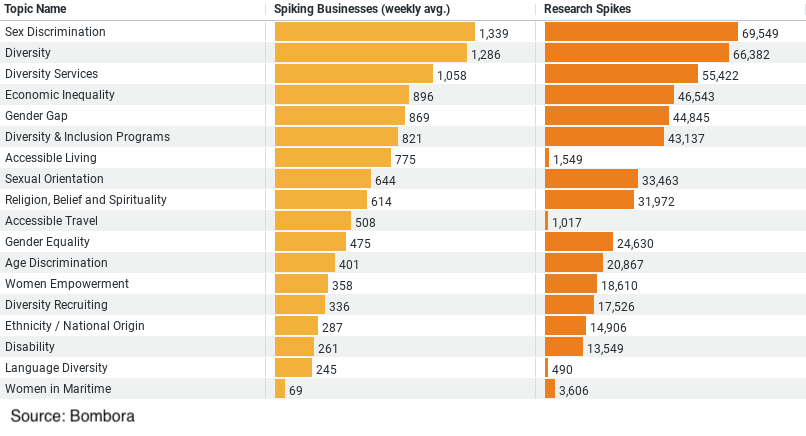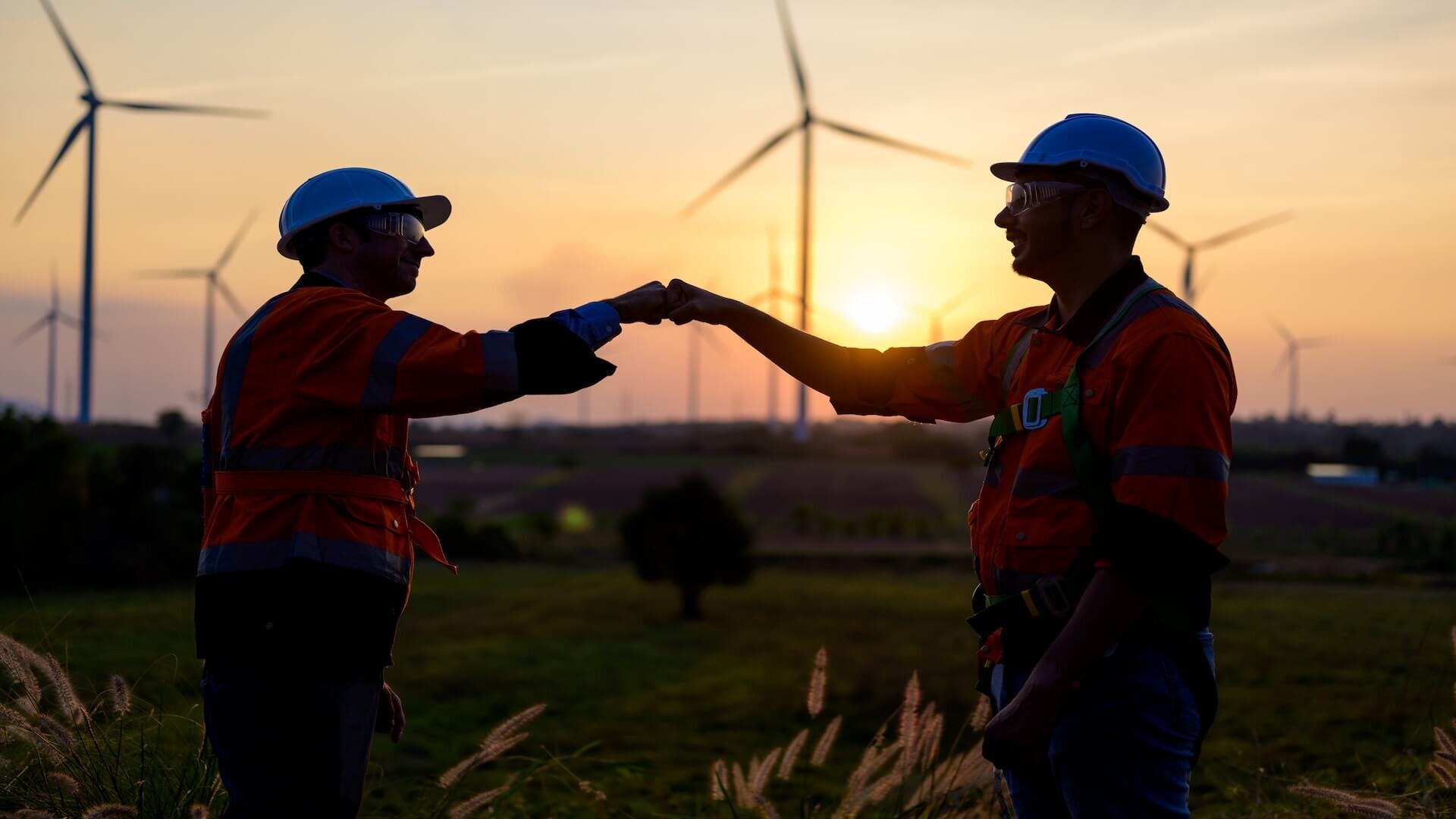Executive Summary: Diversity Research Trends in the Construction Industry
– Sex Discrimination is the most researched topic with the highest engagement, attracting a weekly average of approximately 1,339 businesses and totaling 69,549 research spikes.
– General Diversity issues closely follow, with about 1,286 businesses researching it weekly and a total of 66,382 spikes noted.
– Diversity Services shows significant targeted interest, with an average weekly engagement from 1,058 businesses and a total of 55,422 research instances.
– Economic Inequality and the Gender Gap are also important but less researched compared to the top two topics, indicating a diverse but focused interest in various dimensions of diversity within the industry.
Sex Discrimination Research at the Forefront
The data points to “Sex Discrimination” as the most actively researched topic within the industry. With an impressive weekly average of 1,339 businesses delving into this area, coupled with a total of 69,549 research spikes, it’s clear that this is a hot-button issue. This high level of engagement suggests a proactive approach in tackling sex discrimination, possibly driven by a mix of legal imperatives and a cultural shift towards more inclusive workplace practices. As companies aim to foster safer and more equitable work environments, addressing sex discrimination not only becomes a moral obligation but a strategic asset in attracting and retaining talent.
Broad Concerns with Diversity
Following closely is the broader topic of “Diversity,” with approximately 1,286 businesses engaging in research weekly, resulting in 66,382 spikes. This indicates that the construction industry is not just focusing on isolated issues but is keen on building a comprehensive understanding of diversity. This broad approach may involve integrating diverse perspectives into all aspects of business operations—from hiring and training to project management and client interactions. Such a widespread interest likely stems from the recognition that diverse workforces can enhance creativity, improve decision making, and lead to better problem-solving on the job.
Targeted Research on Diversity Services
“Diversity Services” also emerges as a significant area of interest, with 1,058 businesses exploring this topic weekly and totaling 55,422 research instances. The focus on specialized services suggests that the industry is looking for actionable solutions and strategies to implement diversity initiatives effectively. This could range from consulting services to training programs and policy development tools specifically designed for the unique needs of construction businesses. By investing in such services, companies are not just paying lip service to the idea of diversity but are actively seeking out expertise to operationalize these concepts.
Addressing Economic Inequality and the Gender Gap
The topics of “Economic Inequality” and the “Gender Gap” round out the list of key concerns, albeit with slightly lower engagement compared to the top issues. With 895 and 869 businesses researching these topics weekly, respectively, it’s evident that the industry is also tuning into other critical aspects of diversity. Economic inequality in construction might relate to disparities in pay, opportunities, or resource allocation, while the gender gap highlights the ongoing challenges in attracting and retaining female talent in a predominantly male industry. Addressing these issues is crucial for building a truly inclusive industry that offers equal opportunities for all, regardless of gender, background, or economic status.
Conclusion
The proactive research into these diversity-related topics by the construction industry signifies a paradigm shift. It reflects a broader societal push towards equality and representation, which has started to permeate even the most traditionally rigid sectors. As research continues to inform policies and practices, the construction industry stands on the cusp of significant cultural change. By embracing diversity in all its forms, it not only adheres to ethical standards and compliance but also unlocks a host of benefits associated with a more diverse and inclusive workforce. This shift is not just about being on the right side of history but about building a resilient, innovative, and dynamic industry capable of meeting the challenges of the 21st century.
Company Sample Data
1. Company Size: This categorizes companies based on the number of employees, ranging from micro-sized (1-9 employees) to medium-large (500-999 employees).
2. Spiking Businesses (weekly avg.): Represents the average number of businesses in each size category that are actively researching or showing a spiked interest in the trend weekly.
3. Percent of Total: This shows the percentage each company size category contributes to the total number of businesses showing interest in the trend.
Analysis and Trends
The dataset reveals a diverse level of interest across different company sizes, suggesting varied motivations and resources available for researching or implementing new trends. Here’s a breakdown:
– Micro Companies (1-9 Employees): With an average of 531 weekly spiking businesses and accounting for about 9.4% of the total, these companies show significant activity. This might be driven by the agility and need to quickly adapt to market changes to remain competitive, despite limited resources.
– Small Companies (10-49 Employees): These companies are more engaged, with approximately 1,415 weekly spiking businesses, representing about 25.1% of the total. Small businesses often possess more resources than micro enterprises and might be exploring new trends as a way to expand and innovate within their market.
– Medium-Small Companies (50-199 Employees): This category shows the highest activity with about 1,651 weekly spiking businesses, making up approximately 29.2% of the total. This could be attributed to these companies reaching a size where they can allocate dedicated resources for research and development, driving a higher engagement in industry trends.
– Medium Companies (200-499 Employees): With 852 weekly spiking businesses and 15.1% of the total, these companies likely have established processes and resources to explore and implement new trends systematically, though they may be more cautious in adoption compared to smaller firms.
– Medium-Large Companies (500-999 Employees): They show lesser engagement in the trend compared to smaller sizes, with 448 weekly spiking businesses and 7.9% of the total. As companies grow, they might face increased complexity in adopting new trends rapidly across a larger workforce and multiple departments.
Conclusion
The varying levels of engagement across company sizes reflect the differing capabilities, challenges, and strategies inherent to each size category. Smaller companies tend to react more swiftly to industry trends, potentially to gain a competitive edge or meet niche market demands. In contrast, larger entities might approach new trends with more strategic planning and slower integration, aiming to maintain stability and optimize return on investment. This dataset effectively highlights how business size influences trend adoption, providing valuable insights into the dynamics of business operations across different scales.



